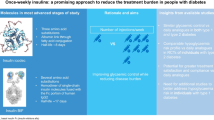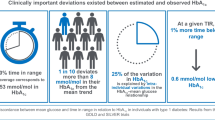Abstract
Background
Hyperglycemia-associated micro- and macro-vascular complications remain the leading cause of premature morbidity and mortality among the diabetic population worldwide. Poor glycemic control due to clinical inertia towards insulin treatment is a major cause behind the development of diabetic complications. In this paper, we analyze different strategies of insulin treatment initialization and titration practiced in India.
Methods
The response of 367 healthcare professionals (HCPs) across the country was recorded based on a survey on demographics, treatment regimens, and patient behavior. For analysis, the responses from HCPs were segregated into six regions, north, south, east, west, and central, covering the entire country.
Results
The survey revealed that 59.1% HCPs preferred using three oral anti-diabetic drugs (OADs) before starting insulin therapy while 12.5% initiated insulin as the last option after trying all available OADs. Besides, 61% HCPs across India considered initiating insulin in type 2 diabetes mellitus (T2DM) patients when the patients (i) failed to achieve glycemic targets with current OADs, or (ii) could not tolerate OADs, or (iii) required a more flexible therapy. In T2DM patients, 52.9% HCPs chose basal only insulin during initiation. In comparison, 63.8% HCPs used basal bolus while initiating insulin in type 1 DM (T1DM) patients. Pan-India, 53.4% HCPs preferred analogue premix while 46.6% HCPs opted for human premix. Next, 98.9% HCPs counselled patients about the risk of hypoglycemia upon initiation of insulin.
Conclusion
This survey outlines an urgent need of reducing the clinical inertia against insulin initialization in Indian settings.



Similar content being viewed by others
References
Mohan V, Shah SN, Joshi SR, Seshiah V, Sahay BK, Banerjee S, Wangnoo SK, Kumar A, Kalra S, Unnikrishnan AG, Sharma SK, Rao PV, Akhtar S, Shetty RV, das A, DiabCare India 2011 Study Group. Current status of management, control, complications and psychosocial aspects of patients with diabetes in India: Results from the DiabCare India 2011 Study. Indian J Endocrinol Metab. 2014;18:370–8.
Omar MS, Khudada K, Safarini S, Mehanna S, Nafach J. DiabCare survey of diabetes management and complications in the Gulf countries. Indian J Endocrinol Metab. 2016;20:219–27.
Tandon N, Kalra S, Balhara YP, Baruah MP, Chadha M, Chandalia HB, et al. Forum for injection technique (FIT), India: The Indian recommendations 2.0, for best practice in insulin injection technique, 2015. Indian J Endocrinol Metab. 2015;19:317–31.
Lovre D, Fonseca V. Benefits of timely basal insulin control in patients with type 2 diabetes. J Diabetes Complications. 2015;29:295–301.
Peyrot M, Rubin RR, Lauritzen T, Skovlund SE, Snoek FJ, Matthews DR, Landgraf R̈, Kleinebreil L, on behalf of the International DAWN Advisory Panel. on behalf of the International DAWN Advisory Board. Resistance to insulin therapy among patients and providers: results of the cross-national Diabetes Attitudes, Wishes, and Needs study (DAWN). Diabetes Care. 2005;28:2673–9.
Rubin RR, Peyrot M, Kruger DF, Travis LB. Barriers to insulin injection therapy: patient and health care provider perspectives. Diabetes Educ. 2009;35:1014–22.
Dailey G, Aurand L, Stewart J, Ameer B, Zhou R. Comparison of three algorithms for initiation and titration of insulin glargine in insulin-naive patients with type 2 diabetes mellitus. J Diabetes. 2014;6:176–83.
Phillips LS, Branch WT, Cook CB, et al. Clinical inertia. Ann Intern Med. 2001;135:825–34.
Zoungas S, Chalmers J, Ninomiya T, et al. Association of HbA1c levels with vascular complications and death in patients with type 2 diabetes: evidence of glycaemic thresholds. Diabetologia. 2012;55:636–43.
The effect of intensive treatment of diabetes on the development and progression of long-term complications in insulin-dependent diabetes mellitus. The diabetes control and complications trial research group. N Engl J Med 1993;329:977-986.
Venkataraman K, Kannan AT, Mohan V. Challenges in diabetes management with particular reference to India. Int J Diabetes Dev Ctries. 2009;29:103–9.
Peyrot M, Rubin RR, Lauritzen T, Skovlund SE, Snoek FJ, Matthews DR, Landgraf R̈, Kleinebreil L, on behalf of the International DAWN Advisory Panel. Resistance to insulin therapy among patients and providers: Results of the cross-national diabetes attitudes, wishes, and needs (DAWN) study. Diabetes Care. 2005;28:2673–9.
Data on file. Action Asia: Indian country session summary, 29th Oct 2011.
Joshi SR, Das AK, Vijay VJ, Mohan V. Challenges in diabetes care in India: Sheer numbers, lack of awareness and inadequate control. J Assoc Physicians India. 2008;56:443–50.
Stumvoll M, Goldstein BJ, van Haeften TW. Type 2 diabetes: principles of pathogenesis and therapy. Lancet. 2005;365:1333–46.
American Diabetes Association. Pharmacologic approaches to glycemic treatment: Standards of medical care in diabetes—2020. Diabetes Care. 2020;43(Suppl 1):S98–110.
International Diabetes Federation Guideline Development Group. Global guideline for type 2 diabetes. Diabetes Res Clin Pract. 2014;104:1–52.
Chawla R, Makkar BM, Aggarwal S, Bajaj S, Das AK, Ghosh S, et al. RSSDI consensus recommendations on insulin therapy in the management of diabetes. Int J Diabetes Dev Ctries. 2019;39:43–92.
Garber AJ, Ligthelm R, Christiansen JS, Liebl A. Premixed insulin treatment for type 2 diabetes: Analogue or human? Diabetes Obes Metab. 2007;9:630–9.
Kramer CK, Zinman B, Retnakaran R. Short-term intensive insulin therapy in type 2 diabetes mellitus: A systematic review and meta-analysis. Lancet Diabetes Endocrinol. 2013;1:28–34.
Seshiah V, Das AK, Balaji V, Joshi SR, Parikh MN. Gupta S;et al. Gestational Diabetes Mellitus Guidelines. JAPI. 2006;54:622–8.
Acknowledgments
The authors thank Vibhuti Jain Rana, Debjyoti Paul, and Pusala Lakshmi Prasanna from Neovation Consultancy Services Pte. Ltd., Singapore, for assisting with statistical analysis and manuscript revision.
Author information
Authors and Affiliations
Corresponding author
Ethics declarations
Conflict of interest
Dr. Nishtha Manish Singh is also a part of the scientific department at Neovation Consultancy Services Pte. Ltd., Singapore.
Additional information
Publisher’s note
Springer Nature remains neutral with regard to jurisdictional claims in published maps and institutional affiliations.
Supplementary Information
ESM 1
(DOCX 28 kb)
Rights and permissions
Springer Nature or its licensor holds exclusive rights to this article under a publishing agreement with the author(s) or other rightsholder(s); author self-archiving of the accepted manuscript version of this article is solely governed by the terms of such publishing agreement and applicable law.
About this article
Cite this article
Hasnani, D., Saboo, B., Chaturvedi, A. et al. Current insulinization trends in India. Int J Diabetes Dev Ctries 43, 363–370 (2023). https://doi.org/10.1007/s13410-022-01123-x
Received:
Accepted:
Published:
Issue Date:
DOI: https://doi.org/10.1007/s13410-022-01123-x




